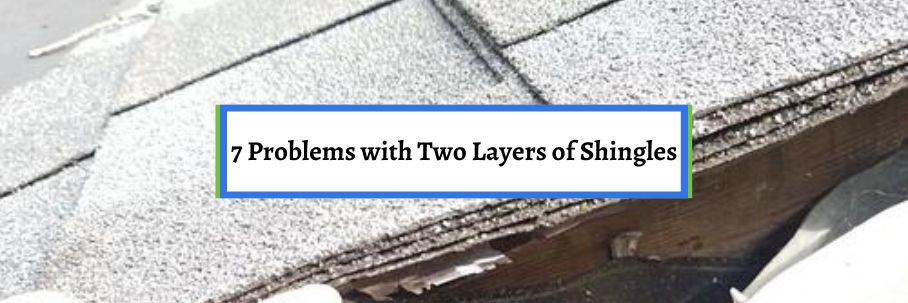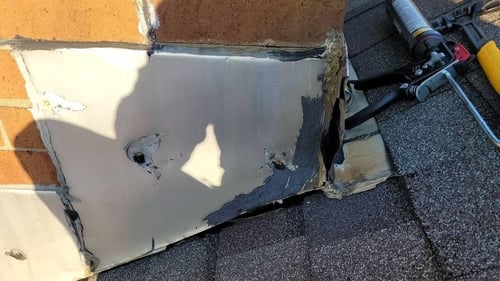7 Problems with Two Layers of Shingles

Getting a new roof isn’t cheap. That’s why homeowners look to save money where possible when the time comes for a roof replacement.
One of the most common ways to try to save money is by adding a second layer of shingles over an old roof. While this is possible, it shouldn’t be done lightly.
That’s why it’s important to know the downside of having two layers of shingles before making a quick decision.
For over 30 years, the team at Bill Ragan Roofing has provided transparent and honest information so homeowners can make the right decisions for their situation. Now, I’ll help you understand the problems that come with two layers of shingles.
This article covers the following problems with two layers of shingles:
- Your roof decking can’t be inspected
- The weight factor of a second layer of shingles
- You have to use your current roof flashing
- You’re covering up an older roof with problems
- Future leaks are harder to repair
- You won’t qualify for the best material warranties
- Potential aesthetic issues
1. Adding a second layer of shingles means you can’t inspect the decking
Roof decking (also known as roof sheathing) is the foundation the rest of the components and materials are installed on. During a full roof replacement, your old roof is torn off down to the decking.
This allows your roofing contractor to inspect the decking’s integrity to see if it can handle your new roof. Well, when adding a second layer of shingles, there’s no way to inspect the condition of your decking before nailing over your old roof.
.jpg?width=500&height=391&name=DeckingRotten%20(2).jpg)
They may feel the sponginess of rotten decking when walking on your roof. However, a roofing contractor won't truly know the roof decking’s condition without tearing off your old roof.
This may not seem like a big deal, but not replacing rotten decking leads to structural issues and even potential health hazards if left unattended. Because of this, a reputable roofer will always recommend tearing off your old roof.
2. Adding a second layer of shingles adds weight to your roof
The next problem with adding two layers of shingles to your roof is the weight factor. An asphalt shingle roof is already heavy, but adding another layer doubles the weight your roof decking has to hold.
And remember, your roofing contractor can’t inspect the condition of your roof decking before adding a second layer of shingles. This means if the decking’s integrity is compromised, it may be unable to handle the weight of the second layer of shingles.
It may happen pretty soon after the second layer is installed or years later, depending on how much rotten decking there is. However, eventually, the weight will damage the structure of your roof and could lead to your roof caving in.
3. Your current roof flashing has to be used
Roof flashing is a crucial roofing component that every roof must have to prevent roof leaks. Flashing is a metal component placed anywhere the shingles butt up against something, like walls, a chimney, or open valleys.
When getting a roof replacement, it’s always recommended to replace your old roof flashing. But when you decide to get a second layer of shingles, your current contractor has to rely on the past contractor’s workmanship and use your roof’s current flashing.
 (Damaged roof flashing)
(Damaged roof flashing)
If the metal’s integrity is compromised, rusted, or the flashing was installed poorly, you shouldn’t entertain the idea of adding a second layer of shingles. If they don’t inspect the condition of your flashing or just flat-out ignore the problems, I guarantee you will have roof leaks in problem areas.
This means spending even more money on repairs and replacing the flashing, which will not be cheap. That’s why you should immediately ask your roofing contractor if they saw any problems with your roof flashing when considering adding a second layer of shingles.
4. A second layer of shingles covers up a roof at the end of its life
A roof replacement’s entire purpose is to replace the roofing materials and components that have reached the end of their lifespan. Like roof flashing, these components and materials won’t get replaced when adding a second layer of shingles.
For example, roof underlayment is installed directly over your decking and acts as your roof system’s last line of defense if water gets underneath the shingles. Again, like roof flashing, you have to rely on the underlayment (that has reached the end of its lifespan) from your old roof.
But the issue isn’t just that you don’t get to replace crucial materials and components. Adding a second layer of shingles also means you’re covering up existing problems or issues.
These problems don’t magically go away and will still be there if water gets underneath the new layer of shingles. After all, you added a second layer of shingles to an asphalt shingle roof near or at the end of its lifespan.
Covering up one layer with another doesn't mean the components stop aging and the potential problems disappear. Which takes us to the next point.
5. Future roof leaks are harder to track with a second layer of shingles
It takes skill to find a roof leak on an asphalt shingle roof, track it, and repair it under normal circumstances. But adding a second layer of shingles makes all this even harder.
If water gets under the new layer of asphalt shingles, it’ll go down your old asphalt roof, find the path of least resistance, and start leaking inside your home. What makes this difficult to repair is that the leak could come from two different parts of two different roofs.
This makes it incredibly hard to find the origin of the leak in your old roof or new layer shingles. Which makes it harder to repair and ensure the roof leak is taken care of the first time.
That’s why it’s best to avoid adding a second layer of shingles altogether if you already have roof leaks.
6. You won’t get the best material warranties available
All asphalt shingles come out of the package with a material warranty from the manufacturer. This doesn’t change when adding a second layer of asphalt shingles.
For example, architectural asphalt shingles have a 30-year warranty that’s prorated after 10 years (coverage diminishes over time). However, you can qualify for the 50-year non-prorated enhanced warranty when you use all the roofing components from one manufacturer for your roof replacement.
Unfortunately, you won’t qualify for the enhanced warranty when adding a second layer of shingles to your roof. This is simply because the manufacturer won’t warranty a roof system that doesn’t have all-new roofing components.
This means any problems or roof leaks that happen on your two-layer roof will have to be taken care of by your roofing contractor’s workmanship warranty.
7. Adding a second layer of shingles could lead to aesthetic issues
When getting a new asphalt shingle roof, you need to consider if you want to keep your current type of shingle or if you want to upgrade. Due to 3-tab asphalt shingles phasing out of the roofing industry, most homeowners are upgrading to architectural shingles.
Well, adding a layer of architectural shingles over 3-tab asphalt shingles causes an aesthetic issue. This is due to 3-tab asphalt shingles running on a 5-inch exposure (you see 5 inches of the shingle out of the full 12 inches), while architectural shingles run on 5 ⅝ inch exposure.
This creates a hump every 8 shingles on your roof that’s noticeable. I understand this isn’t a big deal for every homeowner, but it’s still a problem that needs to be considered when adding a second layer of shingles.
What should you consider before replacing your roof?
Now you know the 7 problems that come with adding a second layer of shingles to your roof. At the end of the day, a reputable roofing contractor will always recommend a full roof replacement.
However, two-layer roofs can be done without problems as long as it’s installed correctly. Just keep these things in mind when deciding if it’s worth nailing over your old roof with a new layer of shingles.
But before making any decisions, there are some things you should consider about replacing your roof. The last thing you want is to regret adding a second layer of shingles instead of getting a full roof replacement.
That’s why I wrote another article with the 5 main things every homeowner needs to consider before starting the roof replacement process.
Check out The 5 Things to Consider When Replacing Your Roof to learn what you need to keep in mind for your upcoming roof replacement.


